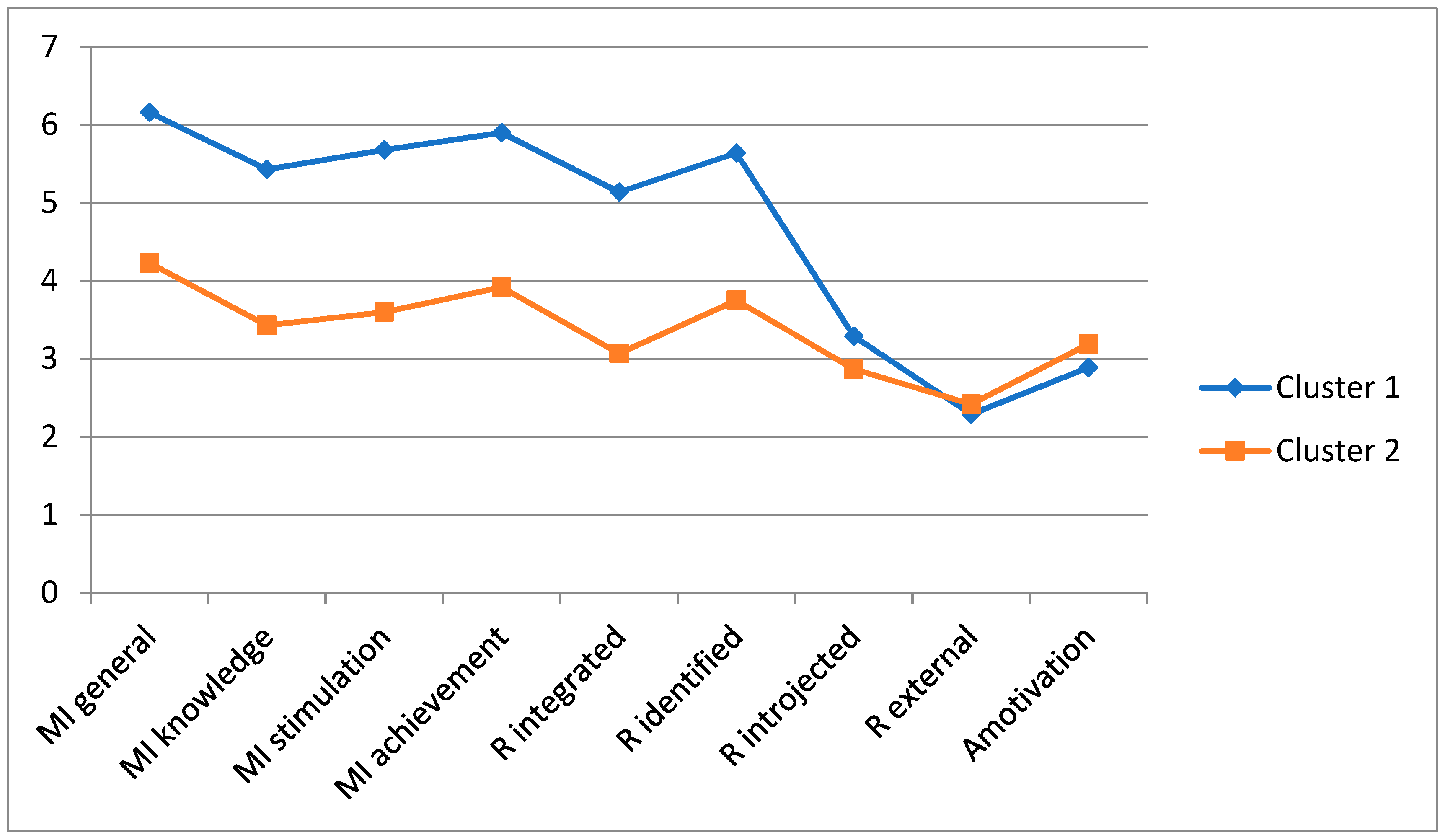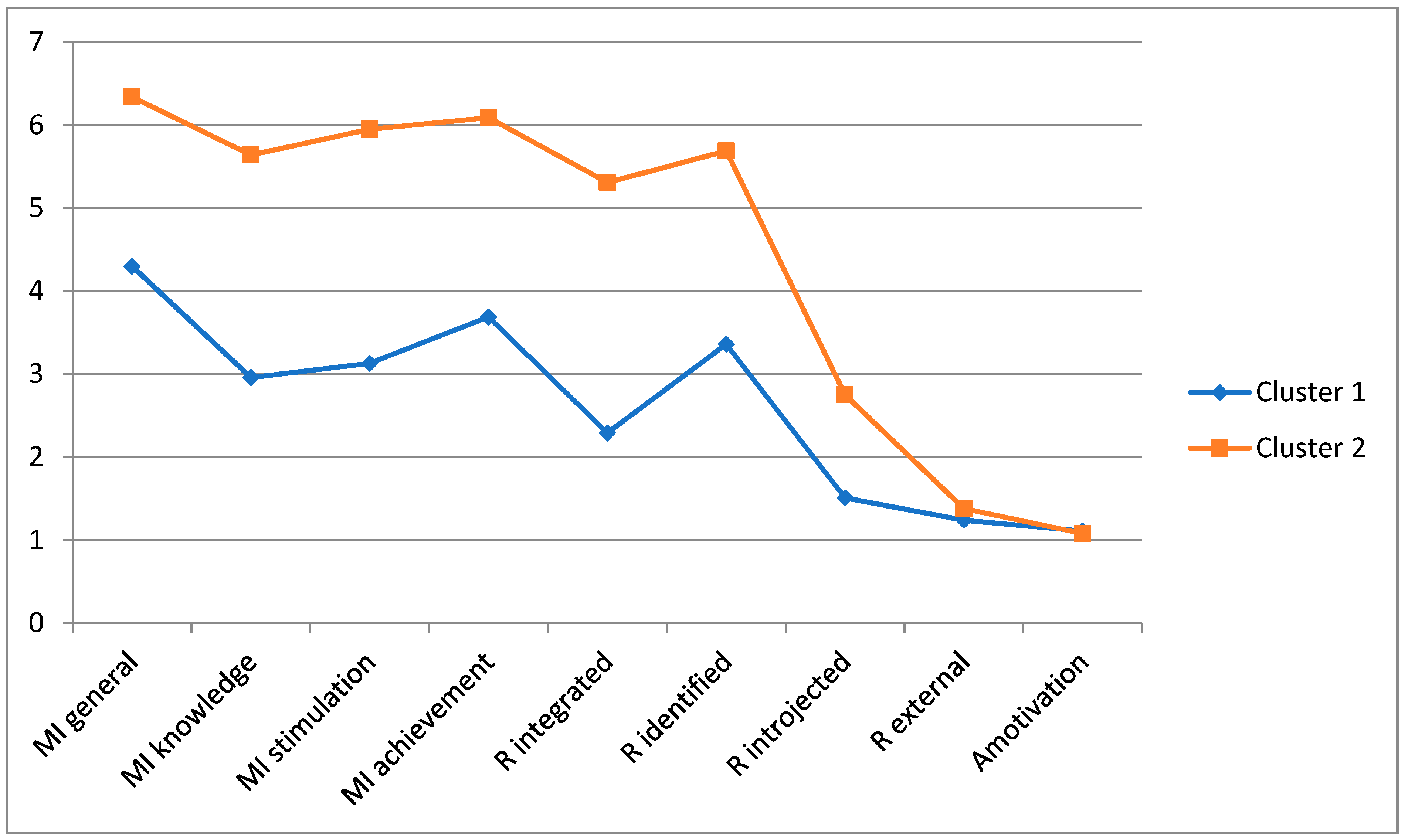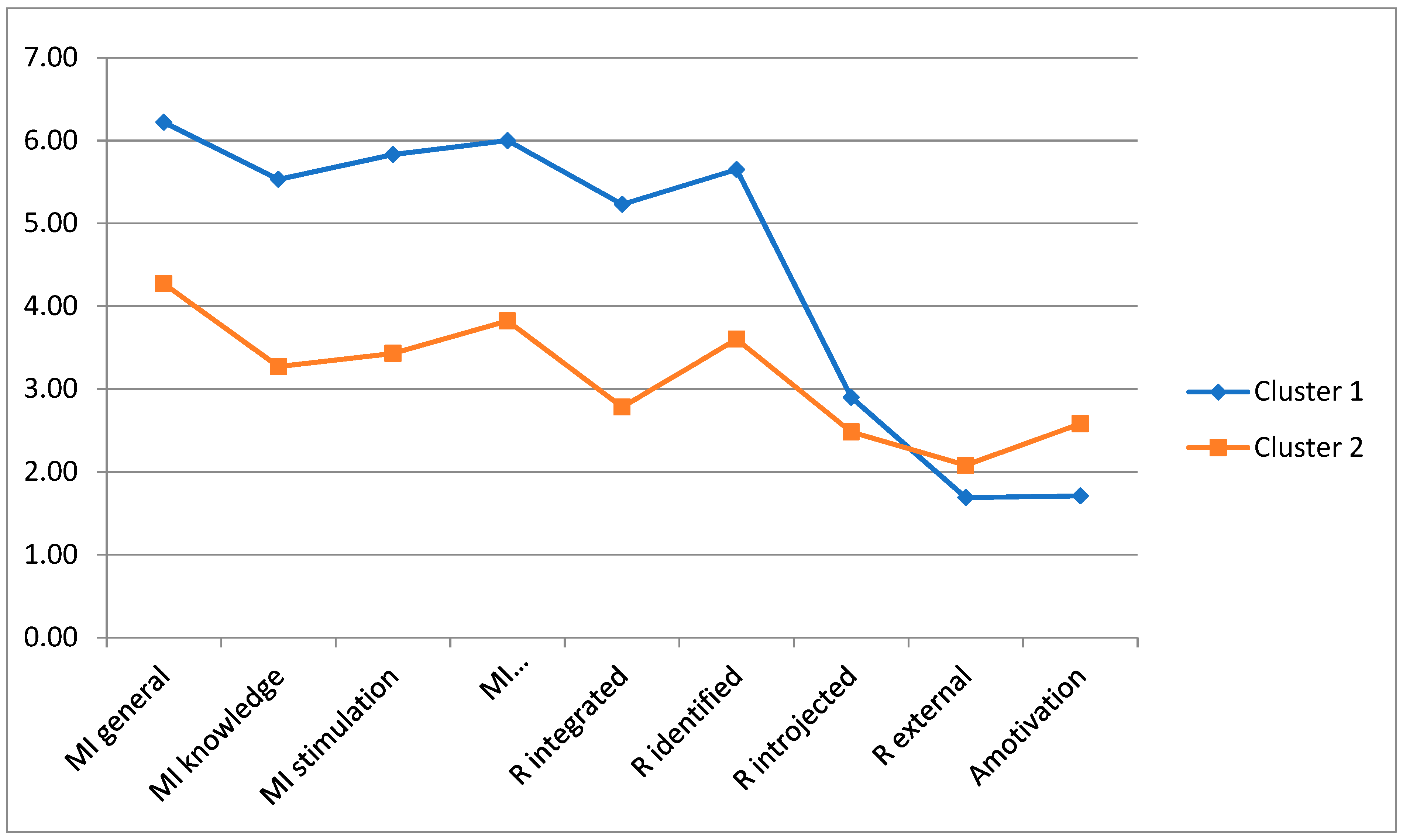Motivational Profiles of High School Physical Education Students: The Role of Controlling Teacher Behavior
Abstract
1. Introduction
2. Materials and Methods
2.1. Ethics Statement
2.2. Participants
2.3. Measures
2.3.1. Controlling Teaching Behaviors
2.3.2. Basic Psychological Needs
2.3.3. Behavioral Regulation in Sport
2.3.4. Importance of Physical Education
2.3.5. Physical Activity Intentions
2.3.6. Habitual Physical Activity
2.4. Procedure
2.5. Data Analysis
3. Results
3.1. Descriptive Statistics
3.2. Cluster Analysis
3.3. Multivariate Analysis
4. Discussion
5. Conclusions
Author Contributions
Funding
Conflicts of Interest
References
- Organización Mundial de la Salud (OMS). Recomendaciones Mundiales Sobre Actividad Física Para la Salud Global Recommendations on Physical Activity for Health. 2010. Available online: http://whqlibdoc.who.int/publications/2010/9789243599977_spa.pdf (accessed on 10 May 2018).
- Shen, B. Physical education and academic performance in urban African American girls. Urban. Educ. 2017, 52, 267–283. [Google Scholar] [CrossRef]
- INE. Determinantes de la salud. Cifras relativas. In Actividad Física Realizada Durante los Últimos 7 Días según Sexo y Grupo de Edad. Población de 15 a 69 Años. De 15 a 24 Años (Determinants of Health. Relative Figures. Physical Activity Performed During the Last 7 Days According to Gender and Age Group. Population of 15 to 69 Years. From 15 to 24 Years old.); Ministerio de Sanidad, Servicios Sociales e Igualdad: Madrid, Spain, 2012. [Google Scholar]
- Caspersen, C.J.; Pereira, M.A.; Curran, K.M. Changes in physical activity patterns in the United States, by sex and cross-sectional age. Med. Sci. Sport Exerc. 2000, 3285, 1601–1609. [Google Scholar] [CrossRef]
- Polet, J.; Hassandra, M.; Luntunen, T.; Laukkanen, A.; Hankonen, N.; Hirvensalo, M.; Tammelin, T.; Hagger, M.S. Using physical education to promote out-of school physical activity in lower secondary school students-arandomized cotrolled trial. BMC Public Health 2019, 19, 157. [Google Scholar] [CrossRef] [PubMed]
- Deci, E.L.; Ryan, R.M. The “what” and “why” of goal pursuits: Human needs and the self-determination of behavior. Psychol. Inq. 2000, 11, 227–268. [Google Scholar] [CrossRef]
- Reeve, J. Autonomy-Supportive teaching: What it is, how to do it. In Building Autonomous Learning; Liu, W., Wang, J., Ryan, R., Eds.; Springer Science and Business Media: Singapore, 2016; pp. 129–153. [Google Scholar] [CrossRef]
- Jang, H.; Reeve, J.; Halusic, M. A new autonomy-supportive way of teaching that increases conceptual learning: Teaching in student’s preferred ways. J. Exp. Educ. 2016, 84, 686–701. [Google Scholar] [CrossRef]
- Moreno-Murcia, J.A.; Huéscar, E.; Belando, N.; Neipp, M.C. Understanding contextual relation in promotion physical exercise from autonomy support. Int. J. Psychol. Stud. 2017, 9, 1–9. [Google Scholar] [CrossRef]
- Haerens, L.; Vanstennkiste, M.; Aelterman, N.; Van den Berghe, L. Toward a systematic study of the dark side of the student motivation: Antecedents and consequences of teachers’ controlling behaviours. In Building Autonomous Learners. Perspectives from Research and Practice Using Self-Determination Theory; Liu, W., Keng, J., Ryan, R., Eds.; Springer: Singapore, 2016; pp. 59–81. [Google Scholar] [CrossRef]
- Reeve, J.; Jang, H.R.; Jang, H. Personality-based antecedents of teachers’ autonomy-supportive and controlling motivating styles. Learn. Individ. Differ. 2018, 62, 12–22. [Google Scholar] [CrossRef]
- Bartholomew, K.; Ntoumanis, N.; Mouratidis, A.; Katartzi, E.; Thøgersen-Ntoumani, C.; Vlachopoulos, S. Beware of your teaching style: A school-year long investigation of controlling teaching and student motivational experiences. Learn. Instr. 2018, 53, 50–63. [Google Scholar] [CrossRef]
- Amado, D.; Sánchez, P.A.; Leo, F.M.; Sánchez, D.; Montero, C.; García-Calvo, T. Análisis de los perfiles motivacionales en practicantes de danza: Diferencias en función de la modalidad (Analysis of the motivational profiles in dance practitioners: Differences depending on the modality). Rev. Psicol. Deporte 2015, 24, 209–216. [Google Scholar]
- Cheon, S.H.; Reeve, J.; Lee, Y.; Lee, J. Why autonomy-supportive interventions work: Explaining the professional development of teachers’s motivating style. Teach. Teach. Educ. 2018, 69, 4351. [Google Scholar] [CrossRef]
- Ryan, R.M.; Deci, E.L. An overview of Self-Determination Theory: An organismic dialectical perspective. In Handbook of Self-Determination Research; Deci, E.L., Ryan, R.M., Eds.; University of Rochester: Rochester, NY, USA, 2002; pp. 3–32. [Google Scholar]
- Hagger, M.; Chatzisarantis, N. The trans-contextual model of autonomous motivation in sport: Conceptual and empirical issues and meta-analysis. Rev. Educ. Res. 2016, 86, 360–407. [Google Scholar] [CrossRef]
- Bartholomew, K.J.; Ntoumanis, N.; Thøgersen-Ntoumani, C. The controlling interpersonal style in a coaching context: Development and initial validation of a psychometric scale. J. Sport Exerc. Psychol. 2010, 32, 193–216. [Google Scholar] [CrossRef] [PubMed]
- Castillo, I.; Tomás, I.; Ntoumanis, N.; Bartholomew, K.; Duda, J.L.; Balaguer, I. Psychometric properties of the Spanish version of the controlling coach behaviors scale in the sport context. Psicothema 2014, 26, 409–414. [Google Scholar]
- Wilson, P.M.; Rogers, W.; Rodgers, W.M.; Wild, T. The psychological need satisfaction in exercise scale. J. Sport Exerc. Psychol. 2006, 28, 231–251. [Google Scholar] [CrossRef]
- Moreno-Murcia, J.A.; Marzo, J.C.; Martínez-Galindo, C.; Conte, L. Validación de la escala de “Satisfacción de las Necesidades Psicológicas Básicas” y del cuestionario de la “Regulación Conductual en el Deporte” al contexto español (Validation of the scale of (Satisfaction of Basic Psychological Needs”and of the questionnaire of “Behavioral Regulation in Sport) to the Spanish context). RICYDE 2011, 26, 355–369. [Google Scholar]
- Londsale, C.; Hodge, K.; Rose, E.A. The development of the behavioral regulation in sport questionnaire (BRSQ): Instrument development and initial validity evidence. J. Sport Exerc. Psychol. 2008, 30, 323–355. [Google Scholar]
- Moreno, J.A.; González-Cutre, D.; Ruiz, L.M. Self-determined motivation and physical education importance. Hum. Mov. 2009, 10, 5–11. [Google Scholar] [CrossRef]
- Hein, V.; Müür, M.; Koka, A. Intention to be physically active after school graduation and its relationship to three types of intrinsic motivation. Eur. Phys. Educ. Rev. 2004, 10, 5–19. [Google Scholar] [CrossRef]
- Moreno, J.A.; Moreno, R.; Cervelló, E. El autoconcepto físico como predictor de la intención de ser físicamente activo (Physical self-concept as a predictor of the intention to be physically active). Psicol. Salud 2007, 17, 261–267. [Google Scholar]
- Sarria, A.; Selles, H.; Canedo-Arguelles, L.; Fleta, J.; Blasco, M.J.; Bueno, M. A self-test for quantifying physical activity in adolescents. Nutrición Clíníca Dietética Hospitalaria 1987, 7, 56–61. [Google Scholar]
- Baecke, J.A.; Burema, J.; Frijters, J.E. A short questionnaire for the measurement of habitual physical activity in epidemiological studies. Am. J. Clin. Nutr. 1982, 36, 936–942. [Google Scholar] [CrossRef]
- Ainsworth, B.E.; Haskell, W.L.; Whitt, M.C.; Irwin, M.L.; Swartz, A.M.; Strath, S.J.; Leon, A.S. Compendium of physical activities: An update of activity codes and MET intensities. Med. Sci. Sports Exerc. 2000, 32, 498–516. [Google Scholar] [CrossRef]
- Hair, J.F.; Anderson, R.E.; Tatham, R.L.; Black, W.C. Multivariate Data Analysis; Prentice-Hall: Upper Saddle River, NJ, USA, 1998. [Google Scholar]
- Norusis, M.J. SPSS/PC+ Professional Statistics, Version 5.0.; SPSS: Chicago, IL, USA, 1992. [Google Scholar]
- Moreno-Murcia, J.A.; Silveira, Y. Perfiles motivacionales de estudiantes universitarios. Procesos de estudio y satisfacción con la vida (Motivational profiles of university students. Processes of study and satisfaction with life). Rev. Electrónica Interuniversitaria Formación Profesorado 2015, 18, 169–181. [Google Scholar] [CrossRef]
- Ryan, R.M.; Deci, E. Self-Determination Theory: Basic Psychological Needs, in Motivation, Development, and Wellness; Guilford: New York, NY, USA, 2017. [Google Scholar]
- Erturan-liker, G.; Yu, C.; Alemdaroglu, U.; Köklü, Y. Basic psychological needs and self-determined motivation in PE to predict health-related fitness level. J. Sport Health Res. 2018, 10, 91–100. [Google Scholar]
- Beltrán-Carrillo, V.J.; Devís-Devís, J.; Peiró-Velert, C.; Brown, D.H. When physical activity participation promotes inactivity: Negative experiences of Spanish adolescents in physical education and sport. Youth Soc. 2012, 44, 3–27. [Google Scholar] [CrossRef]
- Peiró-Velert, C.; Pérez-Gimeno, E.; Valencia-Peris, A. Facilitación de la autonomía en el alumnado dentro de un modelo pedagógico de educación física y salud (Facilitating autonomy in students within a pedagogical model of physical education and health). Tándem Didáctica Educación Física 2012, 40, 28–44. [Google Scholar]
- Escriva-Boulley, G.; Tessier, D.; Ntoumanis, N.; Sarrazin, P. Need-supportive professional development in elementary school physical education: Effects of a cluster-randomized control trial on teachers’ motivating style and student physical activity. Sport Exerc. Perform. Psychol. 2018, 7, 218–234. [Google Scholar] [CrossRef]
- Huéscar, E.; Moreno-Murcia, J.A. Relación del tipo de feed-back del docente con la percepción de autonomía del alumnado en clases de educación física (Relationship of the type of feedback of the teacher with the perception of autonomy of the students in physical education classes). Infancia Aprendizaje 2012, 35, 87–98. [Google Scholar] [CrossRef]
- Rutten, C.; Boen, F.; Seghers, J. How school social and physical environments relate to autonomous motivation in physical education: The mediating role of need satisfaction. J. Teach. Phys. Educ. 2012, 31, 216–230. [Google Scholar] [CrossRef]



| Variables | Dimension | M | SD | R |
|---|---|---|---|---|
| Controlling Teaching Behavior | Teach Control | 2.61 | 1.19 | 1–7 |
| Basic Psychological Needs | Competence | 4.35 | 1.18 | 1–6 |
| Autonomy | 4.01 | 1.08 | 1–6 | |
| Relatedness | 3.70 | 1.03 | 1–6 | |
| Behavioral regulation in sport | IM general | 5.39 | 1.45 | 1–7 |
| IM knowledge | 4.57 | 1.61 | 1–7 | |
| IM stimulation | 4.81 | 1.59 | 1–6 | |
| IM achievement | 5.07 | 1.42 | 1–6 | |
| Integrated Reg | 4.19 | 1.74 | 1–6 | |
| Identified Reg | 4.78 | 1.41 | 1–6 | |
| Introjected Reg | 2.72 | 1.53 | 1–6 | |
| External Reg | 1.86 | 1.20 | 1–6 | |
| Amotivation | 2.08 | 1.30 | 1–6 | |
| Importance of Physical Education | PE Importance | 2.77 | 0.79 | 1–4 |
| Physical activity intentions | Intentions | 3.70 | 0.91 | 1–5 |
| Habitual physical activity | PA Level | 9.85 | 5.21 | 1–5 |
| Dimension | 1 | 2 | 3 | 4 | 5 | 6 | 7 | 8 | 9 | 10 | 11 | 12 | 13 | 14 | 15 | 16 |
|---|---|---|---|---|---|---|---|---|---|---|---|---|---|---|---|---|
| 1.Teach Control | - | −0.08 | −0.02 | 0.09 | −0.11 * | 0.08 | −0.01 | 0.00 | 0.08 | 0.04 | 0.35 ** | 0.45 ** | 0.40 ** | −0.04 | 0.04 | 0.06 |
| 2.Competence | - | - | 0.59 ** | 0.42 ** | 0.54 ** | 0.52 ** | 0.59 ** | 0.57 ** | 0.55 ** | 0.55 ** | 0.13 ** | −0.14 ** | −0.17 ** | 0.35 ** | 0.53 ** | 0.42 ** |
| 3. Autonomy | - | - | - | 0.46 ** | 0.42 ** | 0.46 ** | 0.50 ** | 0.45 ** | 0.45 ** | 0.46 ** | 0.17 ** | −0.05 | −0.09 | 0.30 ** | 0.41 ** | 0.33 ** |
| 4. Relatedness | - | - | - | - | 0.33 ** | 0.39 ** | 0.40 ** | 0.42 ** | 0.42 ** | 0.42 ** | 0.27 ** | 0.12 * | 0.10 | 0.32 ** | 0.35 ** | 0.20 ** |
| 5. IM general | - | - | - | - | - | 0.73 ** | 0.80 ** | 0.70 ** | 0.64 ** | 0.66 ** | 0.12 * | −0.15 ** | −0.28 ** | 00.43 ** | 0.66 ** | 0.44 ** |
| 6. IM knowledge | - | - | - | - | - | - | 0.84 ** | 0.79 ** | 0.74 ** | 0.78 ** | 0.32 ** | 0.04 | −0.16 ** | 0.54 ** | 0.65 ** | 0.50 ** |
| 7. IM stimulation | - | - | - | - | - | - | - | 0.85 ** | 0.75 ** | 0.79 ** | 0.27 ** | −0.04 | −0.18 ** | 0.46 ** | 0.68 ** | 0.52 ** |
| 8. IM achievement | - | - | - | - | - | - | - | - | 0.75 ** | 0.81 ** | 0.31 ** | −0.05 | −0.20 ** | 0.48 ** | 0.66 ** | 0.49 ** |
| 9. Integrated Reg | - | - | - | - | - | - | - | - | - | 0.77 ** | 0.42 ** | 0.06 | −0.10 * | 0.45 ** | 0.68 ** | 0.57 ** |
| 10. Identified Reg | - | - | - | - | - | - | - | - | - | - | 0.40 ** | 0.03 | −0.16 ** | 0.54 ** | 0.66 ** | 0.50 ** |
| 11. Introjected Reg | - | - | - | - | - | - | - | - | - | - | - | 0.55 ** | 0.30 ** | 0.19 ** | 0.27 ** | 0.21 ** |
| 12. External Reg | - | - | - | - | - | - | - | - | - | - | - | - | 0.58 ** | 0.04 | −0.03 | 0.01 |
| 13. Amotivation | - | - | - | - | - | - | - | - | - | - | - | - | - | −0.08 | −0.20 ** | −0.10 * |
| 14. PE Importance | - | - | - | - | - | - | - | - | - | - | - | - | - | - | 0.53** | 0.33 ** |
| 15. Intentions | - | - | - | - | - | - | - | - | - | - | - | - | - | - | - | 0.66 ** |
| 16. PA Level | - | - | - | - | - | - | - | - | - | - | - | - | - | - | - | - |
| Dimension | Sample 1 | Sample 2 | Sample Total | |||||||||
|---|---|---|---|---|---|---|---|---|---|---|---|---|
| Cluster 1 (n = 83) | Cluster 2 (n = 125) | Cluster 1 (n = 57) | Cluster 2 (n = 151) | Cluster 1 (n = 239) | Cluster 2 (n = 177) | |||||||
| M | SD | M | SD | M | SD | M | SD | M | SD | M | SD | |
| IM general | 6.16 | 0.81 | 4.23 | 1.27 | 4.30 | 1.50 | 6.34 | 0.72 | 6.22 | 0.80 | 4.27 | 1.39 |
| IM knowledge | 5.43 | 1.16 | 3.43 | 1.27 | 2.96 | 1.19 | 5.64 | 1.00 | 5.53 | 1.07 | 3.27 | 1.28 |
| IM stimulation | 5.68 | 1.04 | 3.60 | 1.17 | 3.13 | 1.30 | 5.95 | 0.78 | 5.83 | 0.91 | 3.43 | 1.22 |
| IM achieve | 5.90 | 0.88 | 3.92 | 1.08 | 3.69 | 1.10 | 6.09 | 0.73 | 6.00 | 0.80 | 3.82 | 1.09 |
| Integrated Reg | 5.14 | 1.24 | 3.07 | 1.16 | 2.29 | 1.04 | 5.31 | 1.35 | 5.23 | 1.31 | 2.78 | 1.18 |
| Identified Reg | 5.64 | 0.84 | 3.75 | 1.05 | 3.36 | 1.17 | 5.69 | 0.87 | 5.65 | 0.87 | 3.60 | 1.10 |
| Introjected Reg | 3.29 | 1.59 | 2.87 | 1.31 | 1.51 | 0.76 | 2.75 | 1.64 | 2.90 | 1.64 | 2.48 | 1.33 |
| External Reg | 2.29 | 1.43 | 2.42 | 1.36 | 1.24 | 0.76 | 1.38 | 0.63 | 1.69 | 1.08 | 2.08 | 1.33 |
| Amotivation | 2.89 | 1.23 | 3.19 | 1.12 | 1.11 | 0.18 | 1.08 | 0.16 | 1.71 | 1.13 | 2.58 | 1.34 |
| Variables | Cluster 1 Self-Determinated (n = 239) | Cluster 2 Less Self-Determinated (n = 177) | ||||
|---|---|---|---|---|---|---|
| M | DT | M | DT | F | ƞ2 | |
| 1. Controlling Style | 2.50 | 1.15 | 2.76 | 1.21 | 5.22 * | 0.01 |
| 2. Competence | 4.85 | 1.03 | 3.69 | 1.03 | 130.35 ** | 0.24 |
| 3. Autonomy | 4.37 | 1.01 | 3.53 | 0.99 | 72.21 ** | 0.15 |
| 4. Relatedness | 4.00 | 0.99 | 3.30 | 0.95 | 51.67 ** | 0.11 |
| 5. PE Importance | 3.03 | 0.69 | 2.42 | 0.77 | 72.21 ** | 0.15 |
| 6. PA Intentions | 4.18 | 0.67 | 3.05 | 0.78 | 249.09 ** | 0.38 |
| 7. PA Levels | 11.77 | 4.84 | 7.26 | 4.53 | 93.31 ** | 0.19 |
| Wilk’s Λ | 0.56 | |||||
| Multivariate F | 45.50 | |||||
© 2019 by the authors. Licensee MDPI, Basel, Switzerland. This article is an open access article distributed under the terms and conditions of the Creative Commons Attribution (CC BY) license (http://creativecommons.org/licenses/by/4.0/).
Share and Cite
Huéscar Hernández, E.; Moreno-Murcia, J.A.; Ruíz González, L.; León González, J. Motivational Profiles of High School Physical Education Students: The Role of Controlling Teacher Behavior. Int. J. Environ. Res. Public Health 2019, 16, 1714. https://doi.org/10.3390/ijerph16101714
Huéscar Hernández E, Moreno-Murcia JA, Ruíz González L, León González J. Motivational Profiles of High School Physical Education Students: The Role of Controlling Teacher Behavior. International Journal of Environmental Research and Public Health. 2019; 16(10):1714. https://doi.org/10.3390/ijerph16101714
Chicago/Turabian StyleHuéscar Hernández, Elisa, Juan Antonio Moreno-Murcia, Lorena Ruíz González, and Jaime León González. 2019. "Motivational Profiles of High School Physical Education Students: The Role of Controlling Teacher Behavior" International Journal of Environmental Research and Public Health 16, no. 10: 1714. https://doi.org/10.3390/ijerph16101714
APA StyleHuéscar Hernández, E., Moreno-Murcia, J. A., Ruíz González, L., & León González, J. (2019). Motivational Profiles of High School Physical Education Students: The Role of Controlling Teacher Behavior. International Journal of Environmental Research and Public Health, 16(10), 1714. https://doi.org/10.3390/ijerph16101714







